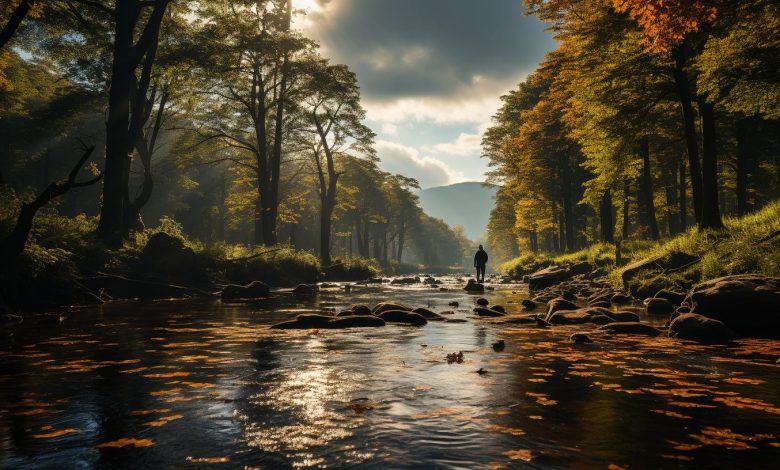Summer Trout Fishing: Strategies For Dealing With Warmwater Conditions

Are you an avid trout fisherman who dreads the summer months? Do you find yourself struggling to catch a single fish in warmwater conditions? If so, don’t give up on summer trout fishing just yet. With the right strategies and techniques, you can increase your chances of success even when the water is warm.
Understanding how warmwater conditions affect trout behavior is crucial for successful summer fishing. As water temperatures rise, trout become more lethargic and less active. They seek out cooler water, often moving into deeper pools or hiding under rocks or other structures. Knowing this, you can adjust your approach accordingly.
By targeting deeper waters and using smaller baits or flies, you’ll be better equipped to entice these sluggish fish into biting. So let’s dive in and explore some effective strategies for dealing with warmwater conditions during summer trout fishing season!
Understand the Effects of Warmwater Conditions on Trout Behavior
When the water gets too warm, trout become sluggish and seek out cool pockets of shade to rest in. This is due to their metabolism slowing down as the water temperature increases.
When the water temperature fluctuates too much, it also affects their behavior and feeding patterns. In these conditions, they tend to feed less frequently and become more selective in their choice of food.
To overcome these challenges, it’s crucial to understand how trout behave during warmwater conditions. One strategy is to fish during cooler times of day when the water temperature is lower. By doing so, you increase your chances of catching active fish that are willing to take your bait or lure.
Fish during Cooler Times of Day
You’ll have better luck catching trout during summer if you aim for the cooler parts of the day. Fishing at dawn or dusk can be effective, as this is when water temperatures are lower and trout are more active. Additionally, fishing at night can also yield great results, especially during a full moon.
To make the most out of fishing at dawn or dusk, try using dry flies or topwater lures to entice feeding trout. During these times, insects and other small creatures are often active on the surface of the water, making it an ideal time for fly fishing. Nighttime trout techniques may include using glow-in-the-dark lures or bait with added scent to attract fish in low light conditions. Always remember to use appropriate safety precautions when fishing in low light conditions.
Now that you know about the benefits of targeting cooler times of day for summer trout fishing, it’s time to explore another strategy: fishing in deeper water.
Fish in Deeper Water
If you’re not having much luck in shallower waters, don’t be afraid to venture out into the deeper parts of the lake or river where larger trout may be lurking. Deeper water strategies can help you catch more fish during the warm summer months when trout tend to move to cooler and deeper waters. One effective strategy is to use sinking lines or weighted flies that allow your bait to sink deeper into the water column.
Another useful technique is to cast your line upstream and let it drift downstream towards deeper pools. This mimics the natural flow of the river and can entice trout that are holding in those areas. Additionally, try using a longer leader and tippet setup which will give your fly more time to sink before it reaches the surface. By utilizing these casting techniques, you’ll have a better chance of reaching those deep pockets where larger trout like to hide.
Transitioning into the next section about ‘use smaller baits or flies’, remember that even when fishing in deeper waters, it’s important to choose an appropriate bait or fly size for optimal success.
Use Smaller Baits or Flies
If you’re struggling to land trout during warm, summer conditions, try downsizing your bait or fly.
Smaller baits and flies can be effective because they mimic the natural food sources that trout are feeding on in these conditions.
Opt for smaller nymphs, dry flies, or streamers to entice even the most finicky fish.
Experiment with different patterns and colors to find what works best in your local waters.
Why Smaller Baits or Flies Can Be Effective
Using smaller baits or flies can be effective when fishing in hot weather, as fish are less likely to expend energy on larger prey. Downsizing your bait has many benefits, such as increasing the chances of a bite and making it easier for the fish to swallow. It also allows for more subtle presentation, which is critical when targeting wary trout in low and clear water conditions.
To evoke an emotional response in the audience, here are some examples of why downsizing your bait or fly can lead to success:
* You’ll catch more fish: Smaller baits allow for more bites, increasing your chances of catching that trophy trout you’ve been dreaming about.
* The challenge is thrilling: Fishing with smaller baits requires skill and patience, but the reward is worth it. When you finally hook that big one, the feeling of accomplishment is unbeatable.
* Trout prefer smaller prey: In warmwater conditions, fish become lethargic and less willing to chase after larger prey. Using a small bait or fly mimics natural food sources during these times.
When using smaller baits or flies, there are many techniques for presenting them effectively. One technique is to use a lighter line weight to ensure that your bait lands delicately on the water’s surface without spooking nearby trout. Another technique is to use a slower retrieve speed than usual so that you can mimic injured prey better. With the right presentation techniques and some patience, you’ll soon find yourself reeling in plenty of trout despite tough summer conditions.
As effective as downsizing your bait may be in hot weather conditions, selecting the best baits or flies will also contribute significantly towards a successful fishing trip.
Best Baits or Flies to Use
The key to a bountiful catch lies in selecting the most suitable bait or fly, as different scenarios call for specific choices. When it comes to summer trout fishing, some of the top locations include streams and rivers that are fed by cold water sources such as springs or underground aquifers. In these areas, you can expect trout to be more active and willing to bite, making it easier to entice them with a variety of baits or flies.
To increase your chances of success, it’s important to use techniques for presenting baits or flies that mimic natural prey items found in the water. For example, if you notice insects hatching on the surface, try using dry flies that resemble those insects. Alternatively, if you see fish feeding on small minnows or other baitfish near the bottom of the stream, consider using nymph patterns that imitate those same prey items. By paying close attention to what’s happening in the water around you and adjusting your approach accordingly, you can greatly improve your chances of hooking into some prized summer trout.
Remember though – while having good technique and proper gear is important when fishing in warmwater conditions during summer season – patience is also key! Don’t get discouraged if bites aren’t coming as quickly as you’d like; sometimes it takes time for fish to become active in warm weather temperatures. Keep casting and stay focused on presenting your bait or fly effectively – before long you’ll have a catch worth bragging about!
Be Patient and Have Realistic Expectations
When it comes to summer trout fishing, patience is key. A successful day on the water depends on your ability to adjust your approach based on trout activity, and having realistic expectations.
Remember to stay positive and enjoy your time outdoors, even if the fish aren’t biting as much as you’d like.
How to Adjust Your Approach Based on Trout Activity
To adapt to the behavior of these fish, you’ll want to observe their movements closely and adjust your methods accordingly.
If the trout are not actively feeding on the surface, for example, you might consider switching to a nymph or streamer pattern that imitates the type of prey they are likely to be targeting. Alternatively, if you notice that trout are rising sporadically in one particular area of a river or stream, it may be worthwhile to focus your efforts there and experiment with different dry fly patterns until you find one that elicits a response.
Another way to adjust your approach based on trout activity is by varying the speed and depth at which you present your flies. During hot summer months when water temperatures can rise above 70 degrees Fahrenheit, trout tend to seek out cooler water and often hold in deeper pools or runs where oxygen levels are higher.
By adjusting your leader length and weight of your flies, you can target these areas more effectively and increase your chances of hooking into a fish.
With these adjustments in mind, let’s take a look at some tips for staying positive and enjoying your day on the water.
Tips for Staying Positive and Enjoying Your Day on the Water
Stay stoked while you’re seeking out success on the stream. Utilize simple yet effective techniques to keep your spirits soaring. Maintaining a positive mindset is key when it comes to enjoying your day on the water, especially during warmwater conditions. Mental preparation can help you stay focused and motivated despite any challenges that may come your way.
To ensure a successful day of trout fishing, it’s important to take breaks and stay hydrated. Being in the sun for hours at a time can take its toll, so make sure to bring plenty of water and snacks to keep yourself fueled. Additionally, taking occasional breaks from fishing allows you to rest, rehydrate, and refocus before returning to the water with renewed energy.
Remember that fishing isn’t just about catching fish – it’s also about enjoying nature and spending time outdoors. By staying positive and taking care of yourself throughout the day, you’ll be able to fully appreciate all that summer trout fishing has to offer.
Conclusion
Congratulations on mastering the strategies for summer trout fishing! By now, you know how warmwater conditions can affect the behavior of trout and how to adjust your tactics accordingly.
Remember to fish during cooler times of day when possible, and focus on deeper waters where trout may seek refuge from the heat. Using smaller baits or flies can also increase your chances of success.
But most importantly, be patient and have realistic expectations. Fishing in warmwater conditions requires a bit more finesse and persistence than in cooler temperatures. As the great John Gierach once said, “The solution to any problem – work, love, money, whatever – is to go fishing.”
So get out there with your newfound knowledge and enjoy the thrill of catching a beautiful trout even in challenging summer conditions. Tight lines!


